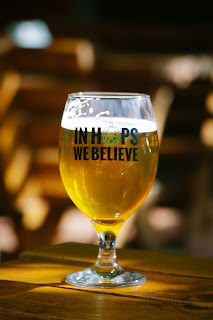What is a Soft Crash?
"Soft Crashing" is a relatively new concept that we first heard about when reading up on Lallemand's Verdant IPA yeast. James Heffron from Verdant Brewing Co mentioned that it's something they implement as part of their fermentation schedule to try and avoid hop creep - a phenomenon that causes over attenuation during fermentation as a result of (usually large) dry hops increasing the amount of fermentable sugars within your wort as a result of enzymatic changes from hops breaking down long chain unfermentable dextrins and making them fermentable.
How to Perform a Soft Crash
The process of soft crashing involves dropping the temperature of your fermenter so it is outside the (lower) recommended temperature range for the yeast you are using. For ales, this would typically mean dropping to 12°C-15°C, and for lagers, dropping to 8°C-10°C.
Benefits of Soft Crashing
Dropping the temperature will achieve several benefits. Firstly, it will cause some of the yeast and sediment to drop out of suspension in your wort. Secondly, the yeast will be too cold to actually ferment anything further which means the risk of hop creep is vastly reduced. It is also believed that the lower temperature helps to prevent the previously mentioned enzymatic changes from occurring as well that convert non-fermentable sugars into fermentable sugars. Finally, soft crashing is believed to also help reduce the impact of hop burn - an astringent flavour in the period immediately following a large dry hop.
Soft Crash Timing
The timing of your soft crash is important. As we know, temperature is a critical factor when dealing with yeast and fermentation. Controlling the temperature during active fermentation ensures that the yeast are healthy, happy, and can convert the sugars from your wort into alcohol and carbon dioxide without imparting any undesirable off flavours into your beer. Towards the end of fermentation, it is recommended the temperature be ramped up 2C-5C for several days for what is known as a diacteyl rest. The warmer temperature helps promote yeast activity so they can more effectively clean up any undesirable diacetyl (or it's precursor alpha-acetolactate) that is still remaining in the beer after fermentation has completed.
Performing your soft crash too early can mean that the diacetyl rest has not been fully completed and will leave traces of diacetyl in your beer. It is therefore important that you don't initiate your soft crash until after the diacetyl rest has been completed.
Dry Hop Additions
Once your soft crash has been initiated and the target temperature has been reached, the dry hops are then added and left for the desired time period. A cold crash is often then begun where the temperature of the fermenter is dropped, typically to serving temperature (2C-4C).
Example Fermentation Schedule with Soft Crash
Here is a typical fermentation schedule that we use for a standard ale fermentation.
- Day 0: Yeast pitched and fermentation started
- Day 1-5: Recommended fermentation temperature maintained (approx 20°C)
- Day 6: Temperature slowly raised to approx 22°C-23°C for diacetyl rest
- Day 7-10: 22°C-23°C temperature maintained for diacetyl rest
- Day 11: Temperature dropped to 15C for soft crash. Once target temperature is reached, dry hops are added
- Day 12-13: Soft crash temperature maintained
- Day 13-14: Cold crash and transfer to keg
Monitoring Fermentation
This is a typical schedule that we use, however, a great way to keep an eye on your fermentation progress in real time is to use a Wi-Fi hydrometer. We use Kegland's RAPT Pill, but there are other varieties available as well such as the Tilt Hydrometer or iSpindel. Seeing the specific gravity (SG) of your fermentation in real time gives you the benefit of beginning to ramp up the temperature of your fermentation using the heat generated from your fermentation when there are only a few specific gravity points left until the expected final gravity is reached.
Here is a real-world fermentation example of our recently brewed Juice Boost NEIPA using our RAPT Pill. The red line represents temperature, and the blue line represents the gravity reading.
Point A shows where primary fermentation was underway, with temperature being more accurately controlled to maintain approx 20 degrees.
At Point B, we allowed the temperature of the fermenter to steadily rise a couple of degrees to 22 using the heat produced at the tail end of fermentation. We didn't have the means to maintain this warmer temperature once fermentation was completed, so you'll notice the temperature slowly decrease between points B and C as a direct result of the colder ambient temperature.
At Point C, we performed our soft crash and dropped the temperature to approx 15c and added our dry hops. After 48 hours, we initiated the cold crash at Point D.
Let us know your thoughts and experiences on dry hopping, hop creep and soft crashing below.
PS: we hope you enjoyed the above article and thank you for reading this far! If you found this article useful, please consider subscribing using the in-page sign up window. It really helps us grow the site, and you'll get a single email from us weekly with links to our latest and greatest content, that's all! Thanks again for checking out our blog.






Thanks! Say after point C you are leaving the dry hops in until after Point D then removing them? This temperature change is more similar to how a lager may go through it's temperature cycles especially for an Octoberfest for example from what I've experienced, except your taking Ales right?
ReplyDeleteHi Kevin! I don't remove the dry hops, after the cold crash (point D) once the temperature has dropped right down (ie. where the graph ends) I transfer the beer from fermenter to keg which essentially gets them off the hops anyway.
ReplyDeleteYes, I'm talking about ales - I aim for a total contact time of approx 48 hours when dry hopping so do it right at the end just before transferring.